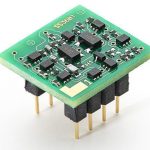Introduction to OpAmps
In order to set expectations for my op-amp posts, I’m going to give a little background on op-amps. These are things I’ve learned along the way and please understand up front, I am not an electronics engineer so some of this may be over simplifications but it serves to set the stage for the rest of this article. To begin with, Operational amplifiers are defined by Webster’s as linear devices used for DC amplification and common to signal conditioning, filtering, and to perform mathematical operations. Most Op-amps are designed to work in conjunction with feedback components such as resistors and/or capacitors and these components determine the resulting function or “Operation” being performed. For this reason, the same Op-amp may be used in circuits designed to do many different functions.

Op-amps are usually 3 terminal devices (two high impedance inputs +/-, and one output). Output is measured as gain and depending on the configuration can be measured as either voltage or current. The most common gain type is voltage, the second most common is current and far less common are transconductance (Voltage in, current out) and transresistance (current in, voltage out). Gain is what we are after in audio applications as the Op-amp is being used to raise the level of the input signal but not all gain is created equal. All op-amps operate within a certain bandwidth that defines what frequencies they operate on. In a perfect world, we would want something with infinite bandwidth, but in reality we have to choose from models that either do best at lower or higher frequencies and most audio op-amps fall into the lower frequency models as high frequency models work at frequencies well above human hearing.
So we have established that gain and bandwidth are the primary factors to look for in audio op-amps, slew rate is probably next in line as it is a measure of how quickly that gain can be applied and removed when called upon to do so (Measured in V/μSecond). We tend to think electricity is instantaneous, but in reality it takes time for voltage and current to change even if it is measured in micro-seconds. To give an example most are probably familiar with, lets look at lighting. When you flip the switch, the time between the press of the button and the time the room is fully lit depends on what type of bulb is in use. Incandescent bulbs seem to be instantaneous, while LEDs sometimes have a moments delay, and fluorescent bulbs often have marked delay and gradually get brighter for some time. In op-amp terms, the Incandescent would have the highest slew rate while fluorescent would have the lowest slew rate. Going back to audio, as you can imagine, the slower the slew rate, the more detail is potentially lost as it is hidden in the slew.

The next consideration is noise and distortion. There is no such thing as a perfect amplifier and all produce some level of noise and some form of distortion. Again, different op-amps do their best work with different types of inputs, feedback circuitry etc… and again, this is a matter of finding the best combination for any single circuit. Note I didn’t say application as circuitry differences can and do make different op-amps function differently even when performing the same function.
As you can see, that simple little chip on the board in your DAC or amp is not so simple, If you could take apart that chip, you’d see that internally basically 4 different operations take place and each requires its own components and paths. Furthermore, the op-amp can be influenced by resistors or capacitors used as part of its feedback loop, so even seeing the same part number on two chips does not indicate the same function. With the ability to modify op-amp behavior with the components around it, it is entirely possible to use op-amps in ways the original designer never intended or envisioned.
 I say all this, to show that there is some science involved in choosing the right op-amp for a given design and if that science were the only consideration, then switching op-amps at the consumer level would be detrimental at worst and uneventful at best. However in all but the highest end products, accounting usually takes precedence over science and we end up with the best op-amp for the job that costs less than one dollar. This leaves plenty of room for improvements for those who are willing to raise that budget ceiling and is why this article exists.
I say all this, to show that there is some science involved in choosing the right op-amp for a given design and if that science were the only consideration, then switching op-amps at the consumer level would be detrimental at worst and uneventful at best. However in all but the highest end products, accounting usually takes precedence over science and we end up with the best op-amp for the job that costs less than one dollar. This leaves plenty of room for improvements for those who are willing to raise that budget ceiling and is why this article exists.
The same consideration of science vs cost goes into producing the chips themselves. There are limitations of what can be done in a single die that come into play and when designing an op-amp a series of compromises are usually made. Manufacturing techniques vary as does the cost of utilizing those techniques, so we see products from <$1 each to $50+ each partially based on cost of manufacture (and partially on what the market will bear). Discrete op-amps have the advantage of decoupling the functions so the limitations of what can be built into a single chip are removed but still often struggle to maintain a size and form factor that will work as a replacement for the smaller IC components and again cost vs performance is still part of the equation.
So with all the choices, what can one really expect when swapping op-amps?
Results of op-amp switches fall into three categories, improvements, lateral moves, and downgrades.
Improved linearity, less coloration, Improved detail, and improved coherency are possible in the best case scenario. Rarely do all of these things happen so more often than not we see improved linearity with roughly the same detail level, or we see improved details, but coloration doesn’t improve etc..
Changes in linearity, coloration, detail or coherency without overall improvement are also possible and are what I put in the lateral move category (As an example, bass is more linear, but treble is pushed forward). Seeing as all of us weight these factors differently, it is entirely possible that an op-amp swap that is technically a lateral move is perceived as an improvement based on which factors are most important to the listener. On the other end of the spectrum, there are times when swapping op-amps results in downgraded performance. This is often caused by introducing an Op-amp with dramatic differences in specifications. Since the circuitry around the op-amp has as large an impact as it does, it is quite possible that optimizations designed for one op-amp are counter productive for others.
The worst case scenario is oscillation which can not only ruin the op-amp, it can destroy the circuitry around it if not detected and corrected quickly. Differences in Load, differences in feedback networks, less than perfect decoupling of the power supplies, and even internal problems with the chip can result in an op-amp “Singing” or oscillating. Here is how it happens, a signal is fed to the input of the op-amp and starts the amplification process. For whatever reason, the feedback signal is delayed or doesn’t reach the op-amp. Slight delays result in overshoot or “ringing” where the op-amp overshoots the output voltage and it may take several feedback cycles to re-regulate the op-amp and reduce the ramp rate and output voltage to proper levels. Larger delays will result in oscillation where the op-amp is in a constant state of over-correction in one direction or the other. The delay in feedback means the op-amp is stuck in a state of reacting to yesterday’s news and never realizes that today it is already partial corrected which results in constant overshoot. You can see how this constant voltage overshoot has the potential to damage the feedback circuitry and anything in the path downstream of the op-amp.
Final thoughts:
- Some argue that switching op-amps poses no risk as long as they are pin-compatible.
- This is false, as has been explained above feedback circuits vary from one op-amp to another and what is optimized for one maybe inappropriate for others.
- Some argue that changing op-amps makes little or no difference to sound.
- Again, false. Op amps of different bandwidths, gain, slew rates, and SNR will change the output. These changes may be small enough to be inaudible, but that is not the same as saying it doesn’t change.
- Changes in sound are improvements.
- Again, false. Just because something sounds different, does not mean it is technically an improvement and often what is technically better is less musical.


